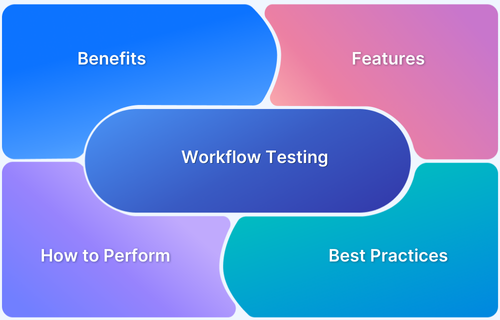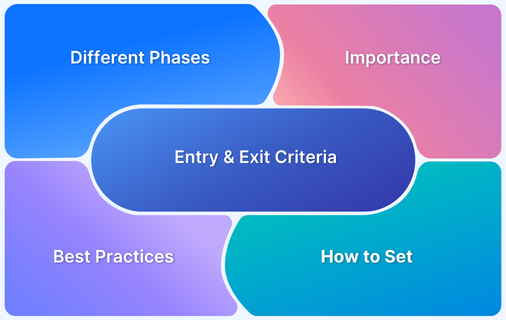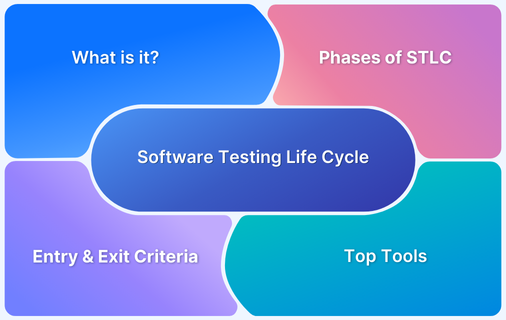A Software workflow must operate flawlessly to meet user expectations. Workflow testing plays a crucial role in achieving this by validating the interconnected steps within a process, ensuring smooth transitions and accurate functionality.
Overview
What is Workflow Testing?
Workflow testing validates the end-to-end functionality of a sequence of tasks within a software process to ensure smooth and accurate execution.
Why Should You Perform Workflow Testing?
- Identifies bottlenecks and process inefficiencies.
- Ensures seamless user experience across workflows.
- Validates interdependencies between multiple components.
Different Phases of Workflow Testing
- Planning: Define workflows and objectives.
- Designing: Create test cases for all process steps.
- Execution: Run tests on real or simulated environments.
- Analysis: Identify and resolve defects.
This guide explains the essentials of workflow testing, from its core concept to its importance in ensuring smooth and error-free software processes.
What is Workflow Testing?
Workflow Testing is a type of software testing that focuses on validating an application’s end-to-end workflows or business processes. It ensures that the entire sequence of operations, from start to finish, performs as expected and that all system components involved in the workflow work together seamlessly.
Why should you perform Workflow Testing?
Workflow Testing is crucial for ensuring that complex systems and processes function as intended. Here are key reasons why you should perform workflow testing:
1. Validate End-to-End Business Processes: Workflow testing ensures that the entire sequence of operations in a process—from start to finish—works as expected. It verifies that all steps in a workflow, along with their dependencies, are functioning correctly.
2. Detect Integration Issues: Modern applications often involve multiple components, systems, or APIs working together. Workflow testing identifies issues that occur at integration points, such as data mismatches or communication errors between systems.
3. Improve User Experience: By testing the application workflow, you can ensure that users can complete their tasks without confusion or interruptions. This reduces frustration, improves satisfaction, and boosts overall usability.
4. Ensure Business Continuity: Critical business processes rely on workflows. Workflow testing ensures that these processes are robust, reducing the risk of disruptions that could impact operations or revenue.
5. Identify Bottlenecks and Errors: Workflow testing helps uncover inefficiencies, misconfigurations, or logical errors within the workflow that might affect performance or cause failures.
6. Compliance with Requirements: It ensures that the workflow adheres to business requirements, regulatory standards, and policies, reducing the risk of non-compliance issues.
7. Validate Data Flow: In workflows that involve data processing, workflow testing ensures that the data flows correctly between steps, maintains integrity, and arrives at the desired destination in the expected format.
8. Ensure Seamless Automation: In automated workflows, especially in DevOps pipelines or business process automation, testing ensures that tasks execute correctly without manual intervention.
9. Reduce Post-Deployment Issues: By identifying workflow issues during the testing phase, you minimize the risk of critical errors appearing in production, reducing maintenance costs and enhancing reliability.
10. Support Scalability and Complexity: As workflows become more complex or involve scaling to handle higher volumes, workflow testing ensures that the system can adapt and handle increased load without breaking.
Importance of Workflow Testing
Workflow testing ensures the smooth and efficient operation of software applications and business processes. By identifying and resolving potential issues early on, workflow testing helps to:
- Improve software quality: It helps to detect and fix defects that may not be apparent in individual component testing, leading to a more robust and reliable final product.
- Enhance user experience: By ensuring that the software functions as expected in real-world scenarios, workflow testing contributes to a more intuitive and satisfying user experience.
- Reduce costs: Identifying and fixing issues early in the development cycle is significantly less expensive than addressing them after deployment.
- Increase efficiency: A well-tested workflow can streamline business processes, leading to faster task completion and improved productivity.
- Boost customer satisfaction: By delivering a high-quality product that meets user expectations, workflow testing helps to build trust and loyalty among customers.
Who should perform Workflow Testing?
Workflow testing should involve collaboration between multiple stakeholders to ensure thorough and effective validation of end-to-end processes. Below are the key roles that should perform or contribute to workflow testing:
- QA Testers: Design, execute, and document workflow test cases to identify and resolve defects.
- Business Analysts: Ensure workflows align with business requirements and cover all scenarios.
- Developers: Fix bugs and validate technical components and integrations.
- System Administrators/DevOps: Validate infrastructure, monitor logs, and test workflows under various conditions.
- Product Owners/Managers: Oversee testing, prioritize workflows, and confirm alignment with business goals.
Features of Workflow Testing
Here are the key features of workflow testing:
- End-to-End Validation: Tests entire processes to ensure seamless functionality across all components.
- Real-World Scenarios: Simulates user behavior to uncover issues missed in unit or integration testing.
- Collaboration: Involves teamwork between developers, testers, and business analysts to align testing with business goals.
- Automation: Uses tools to streamline testing, simulate user interactions, and generate reports efficiently.
- Continuous Improvement: Identifies recurring issues to enhance workflows and improve software quality over time.
Different Phases of Workflow Testing
Workflow testing involves multiple phases to ensure the thorough validation of end-to-end workflows. Below are the typical phases:
Phases of Workflow Testing:
- Requirement Analysis
- Test Planning
- Test Design
- Test Execution
- Defect Management
- Regression Testing
- User Acceptance Testing (UAT)
- Reporting and Documentation
- Maintenance and Continuous Testing
Here is a detailed explanation of each phase:
1. Requirement Analysis
Objective: Understand and document the workflows to be tested.
Key Activities:
- Gather detailed business process and workflow requirements.
- Identify key workflows, their steps, dependencies, and expected outcomes.
- Define the scope of testing, including systems, roles, and data involved.
Deliverable: Workflow test plan and identified test cases.
2. Test Planning
Objective: Develop a detailed strategy for testing the workflows.
Key Activities:
- Define test objectives, testing tools, and techniques to be used.
- Allocate resources and assign responsibilities.
- Create a test schedule, including timelines for each phase.
Deliverable: Test strategy document and resource allocation plan.
3. Test Case Design
Objective: Create test cases and prepare the test environment.
Key Activities:
- Design test cases to cover all workflow paths (happy, alternate, edge cases).
- Develop test data to simulate real-world scenarios.
- Set up the test environment, including system configurations and integrations.
Deliverable: Workflow test cases, test scripts (for automated testing), and prepared test environments.
4. Test Execution
Objective: Execute the designed test cases and validate workflows.
Key Activities:
- Perform manual or automated tests for the workflows.
- Record test results, including any defects or deviations from expected outcomes.
- Collaborate with developers to address and resolve identified issues.
Deliverable: Test execution reports and defect logs.
5. Defect Management
Objective: Track, analyze, and resolve workflow-related defects.
Key Activities:
- Log identified defects with detailed descriptions and replication steps.
- Prioritize defects based on severity and impact on workflows.
- Retest workflows after fixes are implemented.
Deliverable: Updated defect log and validated fixes.
6. Regression Testing
Objective: Ensure recent changes or fixes have not introduced new issues.
Key Activities:
- Re-execute test cases for the workflows after updates or bug fixes.
- Focus on ensuring end-to-end functionality is unaffected by changes.
Deliverable: Regression test reports and confirmation of workflow stability.
7. User Acceptance Testing (UAT)
Objective: Validate workflows from the end-user perspective.
Key Activities:
- Involve stakeholders, such as business users or SMEs, to perform tests.
- Collect feedback on the usability and accuracy of workflows.
- Incorporate changes based on user feedback, if necessary.
Deliverable: UAT sign-off and confirmation of workflow readiness for production.
8. Reporting and Documentation
Objective: Summarize test results and provide insights for decision-making.
Key Activities:
- Compile test reports, including execution summaries and defect trends.
- Document workflow testing outcomes, challenges, and lessons learned.
- Ensure proper archiving of test cases and results for future reference.
Deliverable: Final test report and knowledge base for workflow testing.
9. Maintenance and Continuous Testing
Objective: Ensure workflows remain functional after deployment.
Key Activities:
- Continuously monitor workflows in production for issues.
- Perform periodic regression testing during updates or system changes.
- Update test cases to reflect changes in workflows or business processes.
Deliverable: Updated test cases and ongoing workflow stability.
Read More: Entry and Exit Criteria in Software Testing
How to Perform Workflow Testing?
A Workflow Testing Strategy outlines the approach, processes, tools, and best practices for effectively testing end-to-end workflows in a system.
Here’s how to perform workflow testing:
- Define Objectives: Identify testing goals to ensure workflows align with business requirements and validate end-to-end functionality.
- Understand the Workflow: Document workflows and components and analyze steps, inputs, outputs, roles, and conditions.
- Identify Key Workflows: Prioritize critical workflows, focusing on high-risk, complex, or frequently used processes.
- Define Test Scenarios: Design test scenarios, including happy path, negative path, boundary, performance, and integration testing.
- Prepare Test Data: Create datasets to simulate real-world conditions, including valid, invalid, and boundary inputs under varied loads.
- Set Up the Test Environment: Mirror production settings with configured integrations, test data, and validated compatibility.
- Select Testing Tools: Use tools like Selenium, JUnit, or TestRail for test management, automation, and defect tracking.
- Execute Test Cases: Test each step of the workflow, monitor outputs and logs, and validate integration points for correct communication.
- Validate Results: Verify outputs against expected results, ensure workflow completion, and check error handling and notifications.
- Manage Defects: Log, prioritize, and resolve issues; retest workflows after fixes are implemented.
- Perform Regression Testing: Retest workflows after updates to validate stability and use automation for efficiency.
- Conduct User Acceptance Testing (UAT): Validate workflows with end users or SMEs, incorporate feedback, and ensure readiness for production.
- Review and Report: Document defects, unexpected behavior, and performance metrics and provide a final test sign-off after fixes.
- Continuous Testing: Perform periodic regression testing, monitor workflows in production, and update test cases as workflows evolve.
Read More: What is Software Test Methodology
Writing Test Cases for Workflow Testing
Writing effective test cases for workflow testing involves creating structured and detailed steps to validate each part of the workflow. Here’s a guide to writing test cases:
1. Understand the Workflow
- Analyze Workflow Diagram/Documentation: Identify all steps, inputs, outputs, decision points, integrations, and dependencies in the workflow.
- Break Down the Workflow: Divide it into logical testable units (for example, input validation, processing steps, decision paths).
2. Test Case Structure
A standard test case includes the following components:
- Test Case ID: A unique identifier for the test case (for example, WF001).
- Test Case Title: A short, descriptive title (for example, “Verify Successful Submission of Order”).
- Preconditions: The state or conditions required before executing the test (for example, “User logged in”).
- Test Steps: Detailed steps to execute the workflow (for example, “1. Navigate to the order page, 2. Fill in the order details”).
- Test Data: Specific input data required for the test case (for example, “Order details: item name, quantity”).
- Expected Results: The outcome expected after executing the steps (for example, “Order confirmation message displayed”).
- Postconditions: The state after test execution (for example, “Order saved in the database”).
- Actual Results: The outcome observed during testing (filled during execution).
- Status: Mark as Pass, Fail, or Blocked after execution.
- Comments: Any additional observations, issues, or clarifications.
Read More: Test Case Templates with Examples
3. Categories of Workflow Test Cases
Here are examples of test cases for common workflow testing scenarios:
a. Happy Path Test Cases
Objective: Validate that the workflow functions correctly with valid inputs.
- Example Test Case:
- Test Case ID: WF001
- Title: Verify Successful User Registration.
- Preconditions: User is on the registration page.
- Test Steps:
- Enter valid user details (name, email, password).
- Click the “Register” button.
- Test Data:
- Name: John Doe
- Email: john.doe@example.com
- Password: P@ssword123
- Expected Results: User is registered successfully, and a welcome message is displayed.
b. Negative Path Test Cases
Objective: Ensure the workflow handles invalid inputs gracefully.
Example Test Case:
- Test Case ID: WF002
- Title: Verify Error Message for Missing Mandatory Fields.
- Preconditions: User is on the registration page.
- Test Steps:
- Leave the “Email” field blank.
- Click the “Register” button.
- Test Data:
- Name: John Doe
- Email: (Blank)
- Password: P@ssword123
- Expected Results: An error message, “Email is required,” is displayed
c. Boundary Test Cases
Objective: Test the limits of the workflow (for example, maximum and minimum values).
Example Test Case:
- Test Case ID: WF003
- Title: Verify Maximum Character Limit for the Name Field.
- Preconditions: User is on the registration page.
- Test Steps:
- Enter a name with 256 characters.
- Click the “Register” button.
- Test Data:
- Name: 256-character string.
- Email: valid@example.com
- Password: P@ssword123
- Expected Results: An error message, “Name cannot exceed 255 characters,” is displayed.
Read More: Use Case vs Test Case: Core Differences
d. Decision Point Test Cases
Objective: Verify paths taken based on decision points in the workflow.
Example Test Case:
- Test Case ID: WF004
- Title: Verify Workflow Redirection for Premium Users.
- Preconditions: User logged in as a premium subscriber.
- Test Steps:
- Navigate to the homepage.
- Perform an action that is available only to premium users.
- Expected Results: User is redirected to the premium services dashboard.
e. Integration Test Cases
Objective: Ensure systems or components communicate correctly within the workflow.
Example Test Case:
- Test Case ID: WF005
- Title: Verify Payment Gateway Integration.
- Preconditions: User has items in the cart.
- Test Steps:
- Proceed to checkout.
- Enter payment details and submit.
- Test Data: Valid payment card details.
- Expected Results: Payment is processed successfully, and an order confirmation is displayed.
f. Performance Test Cases
Objective: Validate the workflow’s performance under various conditions.
Example Test Case:
- Test Case ID: WF006
- Title: Verify Workflow Performance Under High Load.
- Preconditions: Test environment set up for load testing.
- Test Steps:
- Simulate 1,000 users performing the workflow simultaneously.
- Expected Results: Workflow processes requests without crashing, and response times are within acceptable limits.
Read More: How to write Test Cases in Software Testing
Best Practices for Writing Workflow Test Cases
Here is a list of best practices to be followed when writing test cases for Workflow Testing:
- Be Clear and Concise: Use simple and precise language for steps and expected results.
- Use Unique IDs: Ensure each test case has a unique identifier for tracking.
- Focus on End-to-End Testing: Test the entire workflow from start to finish, considering all dependencies.
- Include Test Data: Provide specific, realistic test data for each case.
- Review Regularly: Update test cases as the workflow evolves.
Why execute Workflow Testing on Real Devices?
Executing workflow testing on real devices is crucial for ensuring workflow reliability, usability, and performance, especially in environments where user interaction with devices plays a significant role.
Here are the main reasons to perform workflow testing on real devices:
1. Realistic Environment
- Authentic User Experience: Real devices replicate the exact conditions under which end-users will interact with the application or system.
- Device-Specific Behavior: Applications and workflows may behave differently on real devices due to hardware and software differences (for example, screen size, resolution, touch sensitivity, processing power).
2. Hardware and Software Variability
- Device Fragmentation: Testing on real devices helps account for the variety of devices (for example, Android vs. iOS, different brands and models) and operating systems used by customers.
- Real Hardware Interactions: Simulators or emulators often cannot mimic device-specific hardware features like cameras, sensors, or biometric authentication.
3. Performance Accuracy
- True Performance Metrics: Real devices provide accurate insights into load times, response times, and overall workflow performance, which may differ on emulators.
- Battery Usage and Resource Consumption: Test the workflow’s impact on device battery life, CPU usage, memory, and network.
4. Network Conditions
- Real-World Connectivity: On real devices, you can test workflows under varying network conditions such as Wi-Fi, 4G, or 5G, or simulate poor connectivity, latency, and packet loss.
- Offline Scenarios: Test workflows that require offline functionality or data synchronization under real network interruptions.
5. Cross-Browser and Cross-Platform Testing
- Browser-Specific Issues: Web-based workflows may render or behave differently on mobile browsers (for example, Safari, Chrome, or Edge). Testing on real devices ensures compatibility.
- Platform-Specific Functionality: Differences between iOS and Android platforms (such as gesture controls or push notification handling) can only be fully validated on real devices.
6. Usability Testing
- Touch and Gesture Testing: Evaluate the ease of navigation, tap responsiveness, and multi-touch gestures, which are critical for mobile workflows.
- UI/UX Validation: Test how the workflow’s interface and layout adapt to different screen sizes and resolutions.
7. Integration Testing
- Third-Party Services: Verify the proper functioning of integrations like payment gateways, GPS, or device-specific APIs (for example, camera or Bluetooth).
- Peripheral Testing: Test workflows that involve external devices like printers, scanners, or IoT devices.
8. Accessibility Testing
- Assistive Features: Ensure the workflow is accessible on real devices, including compatibility with screen readers, magnification tools, and voice control features.
- Physical Constraints: Validate workflows for users with disabilities or those relying on specific device accessibility settings.
9. Regulatory and Compliance Testing
- Adherence to Standards: Some workflows may need to comply with legal or industry standards, such as GDPR or HIPAA, which often mandate real-device testing to ensure security and proper data handling.
10. Increased Reliability and Confidence
- Minimize Risks: Real-device testing reduces the likelihood of critical issues arising after deployment by uncovering device-specific bugs that emulators or simulators might miss.
- Higher Customer Satisfaction: By testing on real devices, you can deliver a seamless and consistent experience to end-users, leading to improved satisfaction and trust.
Why perform Workflow testing with BrowserStack?
BrowserStack is a cloud-based testing platform that provides access to real devices and browsers for testing web and mobile applications. It can significantly enhance workflow testing by allowing teams to perform comprehensive and realistic testing without the need for physical infrastructure.
Here’s how BrowserStack helps with workflow testing:
1. Access to Real Devices and Browsers
- Diverse Testing Environments: BrowserStack offers a wide range of devices, operating systems, and browsers, enabling you to test workflows across different environments (for example, Android, iOS, Chrome, Safari, Edge).
- Device-Specific Testing: Test workflows on real devices to validate hardware-specific features like touch gestures, camera functionality, and sensors.
2. Cross-Browser Testing
- Multiple Browsers: Ensure that workflows function seamlessly on various browsers such as Chrome, Safari, Firefox, and Edge.
- Responsive Design Testing: Verify that workflows adapt correctly to different screen sizes and resolutions.
3. Cloud-Based Testing
- No Infrastructure Required: BrowserStack eliminates the need to maintain a physical device lab by providing virtual access to real devices and browsers.
- Scalability: Easily scale testing efforts to include additional devices, browsers, or configurations as needed.
4. Real-World Network Conditions
- Simulate Network Speeds: Test workflows under different network conditions like 3G, 4G, or slower connections to evaluate performance.
- Offline Testing: Validate how workflows behave with intermittent connectivity or offline scenarios.
5. Integration with Testing Frameworks
- Automation Support: BrowserStack supports popular test automation frameworks like Selenium, Appium, and Cypress, allowing you to automate workflow testing.
- CI/CD Integration: Seamlessly integrate with CI/CD tools like Jenkins, GitHub Actions, or Azure DevOps to enable continuous workflow testing.
6. Debugging and Insights
- Real-Time Debugging: BrowserStack provides features like screenshots, video recordings, and logs, which help identify and resolve workflow issues quickly.
- Error Reproduction: Recreate issues encountered in specific environments for faster debugging and resolution.
7. Mobile App Workflow Testing
- Native App Testing: Test workflows for native mobile applications across a variety of real devices.
- Hybrid and Web App Testing: Validate workflows in hybrid apps and mobile web browsers.
Conclusion
Workflow testing ensures your processes run smoothly from start to finish. It helps catch errors, improve efficiency, and make sure everything works as expected for your users. With the right approach, workflow testing can save time, reduce risks, and deliver better results.
BrowserStack makes workflow testing easier by letting you test on real devices and browsers across various operating systems in the cloud. Whether you’re running manual or automated tests, it helps you quickly catch and fix issues so your workflows are always reliable and ready for action.





